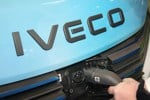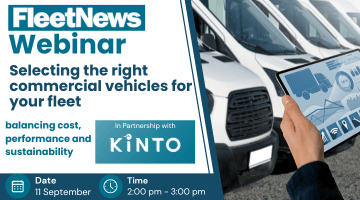A lthough there is a strong legal and moral incentive to keep your fleet and drivers safe, there is also a financial case.
Increased safety reduces accidents, which reduces costs – not just in bent metal terms, but with all the associated issues, such as vehicle and driver downtime and improved staff morale.
Additionally, safe drivers are generally more economical drivers, which results in improved fuel efficiency and a reduced carbon footprint.
Steve Johnson, of driver training firm Drive & Survive and the Fleet Safety Association, says: “Based on figures that we obtained from a major insurer a couple of years ago now, it is a fair assumption that a fleet will have an accident rate of about 65%, which for a fleet of 750 vehicles equals 487.5 incidents.
Although I’ve seen figures for the average crash repair put at £875 we still use a more modest figure such as £750.
On that basis that fleet is going to cost the employer £365,625 per year to run just in crash-related cost alone.”
Mr Johnson estimates that if a fleet were to implement a full driver risk assessment and management programme and the resultant recommendations were followed, the incident rate could drop by as much as 20%, representing savings in excess of £73,000 in the first year.
“Conservatively, savings in years two and three should be of the order of 5% reduction per annum,” Mr Johnson says.
“A properly run driver risk management programme should therefore do far better than break even – it should produce a positive return on investment.”
Add to this potential insurance premium savings and a reduction in minor bumps and scrapes that might not be worth claiming on insurance but can affect a car’s residual value.
“Although hard to prove scientifically, we have had many customers report an improvement in general wear and tear costs too, thanks to the increased mechanical sympathy that trained drivers display,” Mr Johnson says.
“We estimate that a driver who has completed a Drive & Survive course is going to improve his tyre wear rate by up to 20%, reduce brake wear by 15% and clutch wear by 10%.”
Lastly, what about brand reputation?
A serious crash can have a devastating effect on brand reputation, particularly if it hits the media or the vehicle carries the firm’s logo or livery.
BT’s fleet risk management programme has risk assessed more than 10,000 people a year since initial trials took place in 2002.
The introduction of the Virtual Risk Manager programme has been labelled a great success, with collision rates and costs reduced by approximately 40% over the five years.
BT’s group risk manager, Dave Wallington, said: “The results achieved so far have repaid our investment several times over and the ongoing system development will allow us even better visibility and linkages of all our risk assessment, training, collision and hopefully licence data streams.”
Wallington said BT’s accident rate had reduced by 30% over the past four years as part of an on-going commitment to improved driver safety.
Family-run firm Direct Communications, in Cambridgeshire, saw its insurance premiums fall by £20,000.
Its high-mileage fleet of 25 vans and 22 company cars clocks up around 1.4 million miles a year.
Following the implementation of a DriveTech road risk management programme, it saw its comprehensive insurance premiums fall from £60,000 in 2006/07 to £40,000 for 2007/08.
The company has also seen its insurance excess fall from £500 to £250.
Since it introduced the programme, the firm has recorded just two at-fault crashes – both rear-end shunts 14 months apart.
Vehicles were also involved in three non-fault incidents.
Before installing the system, there was at least one write off a year and a number of other incidents.
The decision to adopt a programme after two write offs, four other at-fault accidents and several other crashes within eight months in 2005.
Fleet manager Gavin Bailey says: “The savings that the company is making in insurance premiums is proof that putting in place comprehensive risk management processes really does improve the safety of our staff and other road users.
“The crashes not only cost the business financially but also resulted in a significant rise in fleet administration. In addition to the upheaval to our business and the risk of injury to our employees, such incidents can impact on our customers.
“I am delighted at the results. The cost of the programme, which is ongoing, has more than been paid for by the insurance premium savings.
“Not only that but we have improved our business efficiency and effectiveness because vehicle downtime has been massively reduced.
“Also, wear and tear on vehicles has also been cut as employees now have a smoother driving style and take more responsibility for the cars and vans.”
Chelmsford Electrical provides electrical services for the building and property development sector.
Its drivers cover both urban and rural environments as well as motorway journeys, and frequently encounter partly-completed road infrastructure on new industrial estates, housing developments and other projects.
The vehicles often carry high-value cargo, so personal security, theft and anti-vehicle hijacking are other considerations.
The firm offers a 24/7 emergency maintenance and repair service which means drivers work to tight timescales at all hours of the day and night.
The company has been a client of driver training firm Drive & Survive since 2001, during which time there has been a rolling programme of driver training for the drivers of its 30 vans.
During 1998/99, Chelmsford Electrical had four claims totalling £14,885. But in the following year there were 13 crashes costing £30,442.
This meant the firm’s insurers were prepared to renew the policy only if renewal rates were drastically raised.
The policy was then switched to another insurer, but the costs rose again to £41,670.00 from 33 claims before any driver training took place.
The insurer suggested a driver training programme and offered to reduce the insurance premium by an amount equivalent to the cost of the training.
After a year, such was the turnaround that the insurer offered a 10% rebate on Chelmsford Electrical’s premium.
The number of claims dropped to eight, costing just £4,710 – a reduction of 89%.
The effect on insurance has been dramatic – the premium per vehicle has dropped from £1,350 in 2001/02 to £483 in 2006/07.
Technology company 3M has a UK fleet of 800 cars for management, sales and technical staff.
It currently has an annual average accident rate of 26% over the last seven years – 10% down on previous years and representing savings of around £55,000 a year.
The firm’s insurance premiums have also remained static since the turn of the millennium, as have accident repair costs. The personal injury rate is just three a year.
In 2000, 3M outsourced its accident management programme to WNS Assistance.
“The first benefit of using a specialist service is that it saves an enormous amount of driver and administrative time as, following an accident, one call is all it takes to offload the entire responsibility for any repairs,” explains Martin Dobson, an insurance executive at 3M.
“Outsourcing ensures that downtime is minimised and costs controlled, but not at the expense of the quality of repair.”
A risk assessment of drivers has led to targeted driver training, which Mr Dobson believes is essential to reducing accidents.
The driver training programme was initially introduced on Mr Dobson’s appointment 15 years ago.
That appointment, in turn, was at least partly the result of what the company considered an unacceptable number of road traffic accidents involving 3M drivers.
“Every driver spends a half-day out on the road with an instructor,” explains Mr Dobson, “following some initial classroom-based instruction.
We then receive an assessment from the instructor about whether they might need any additional training, whether classroom-based or out on the road, so that by the end of the process we’re confident in the ability of every one of our company car drivers to avoid accidents.”
Drivers receive a refresher course every five years, while all new employees with company cars are also enrolled on the training course as soon as possible after joining.
All drivers are also required to provide 3M with a copy of their driving licence each year.
“The risk management programme as a whole has already reduced the number of accidents from one-in-three to one-in-four per annum and we hope to get it lower still,” said Mr Dobson.
“This is what accident management really means – not just dealing with those that have occurred, but doing all we can to prevent further accidents. Prevention is always better than repair.”













Login to comment
Comments
No comments have been made yet.